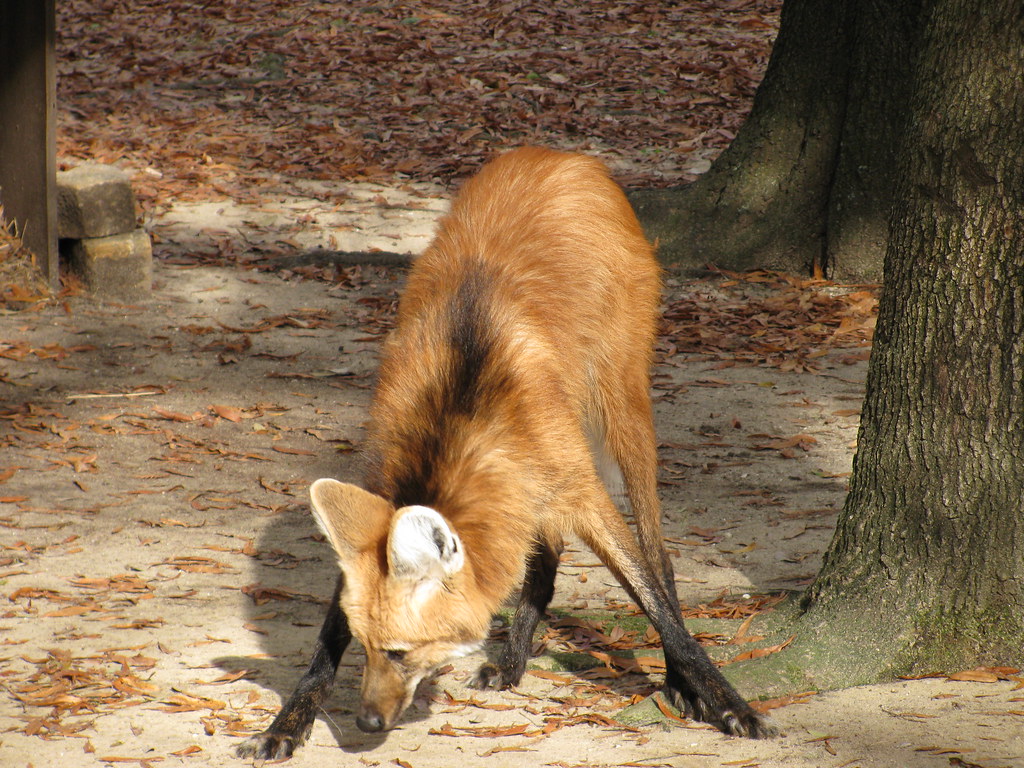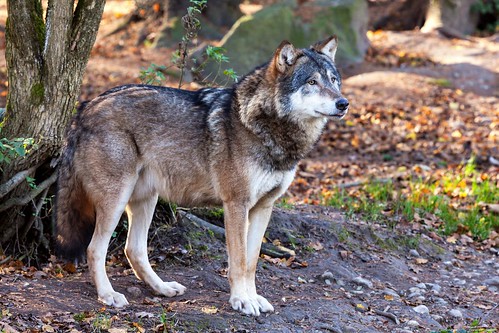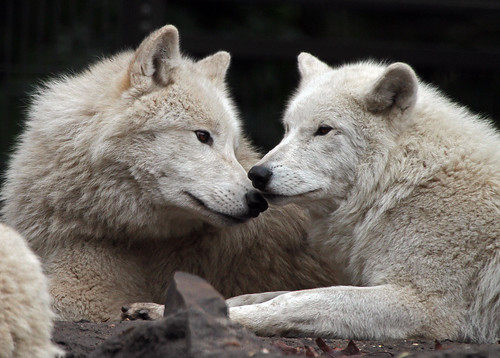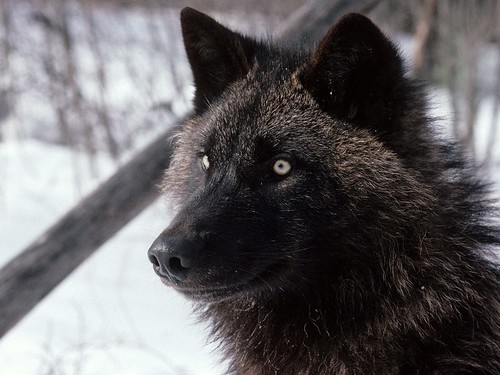Nov 27, 2013 //

People stuff themselves with pumpkin pie after wolfing
down Thanksgiving dinner. However, wolves, coyotes and foxes dined on
pumpkins stuffed with canine delicacies at the Wolf Park in Battle
Creek, Indiana's annual Pumpkin Party. Just as human families may have
simmering tensions beneath the Thanksgiving holiday harmony, wolves too
have family feuds. Renki, the male gray wolf (Canis lupus) shown here, once lost a power struggle with his two younger brothers in the park's main pack.





Complex social interactions determine which wolf claims
the rights of the alpha, or dominant, animal. Renki's family feud pitted
him against his younger brothers, the litter-mates Wolfgang and Wotan
(shown here), in a battle for supremacy. The wolves' caretakers
eventually had to move Renki into a separate pack to protect him from
his not-so-little brothers. Move over Loki and Thor, the brawling
brothers Wolfgang and Wotan now have their own dynastic dilemma.
Although Wolfgang rose to dominate the pack, Wotan has never completely
given up his aspirations to be top dog. Wotan, named for the chief god
in the Germanic pagan pantheon, may yet live up to his namesakes'
grandeur.
 The Wolf Park uses the pumpkins as “enrichment,” or a
situation designed to break the daily routine of the sanctuary's wolves,
coyotes and foxes. Animals in captivity benefit mentally and physically
from enrichment activities and the challenge of figuring out new
problems, such as getting at the goodies hidden in a pumpkin. Here,
15-year-old female gray wolf Marion paws at her pumpkin. Like Wolfgang,
Marion rules other wolves as an alpha. Marion rose to her status despite
being the smallest wolf in the park.
The Wolf Park uses the pumpkins as “enrichment,” or a
situation designed to break the daily routine of the sanctuary's wolves,
coyotes and foxes. Animals in captivity benefit mentally and physically
from enrichment activities and the challenge of figuring out new
problems, such as getting at the goodies hidden in a pumpkin. Here,
15-year-old female gray wolf Marion paws at her pumpkin. Like Wolfgang,
Marion rules other wolves as an alpha. Marion rose to her status despite
being the smallest wolf in the park.



Wolfgang (shown here) and his brothers may have a
dysfunctional family, but he still manages to express his artistic side.
Wolfgang learned that when he jumps backwards repeatedly his delighted
human audience will give him treats. Wolfgang even takes a cue from W.
Amadeus Mozart and hops in unison with one of his caretakers while she
hums a waltz.


Dharma seems to be using her pumpkin to go
trick-or-treating. She lives in the main pack and is mother to
Wolfgang's pups. When Dharma herself was a pup, a series of experiments
studied her behavior, along with nine other wolf pups, in comparison to
that of domesticated dog puppies. Dharma tended to seek out new areas to
explore more than the dog puppies. She also showed less interest in
unknown individuals and new objects than the dogs.


Dharma and Wolfgang's daughter, Fiona, could try out as an
extra in a zombie flick. She seemed to have a knack for nibbling on
noggins. Instead of brains inside the pumpkin, Fiona found treats, such
as pig ears, cheese and dog biscuits. Wild wolves don't regularly hunt
jack-o'-lanterns. However, the skills Fiona needed to get the good stuff
out of the pumpkin were similar to the abilities wild wolves use to
forage, hunt and share prey.

The Pumpkin Party wasn't a wolves-only event. Hunter and Gypsum, two gray foxes (Urocyon cinereoargenteus)
also got to disembowel a pumpkin. Gray foxes range in the wild from
Canada to Venezuela. In the wild, gray foxes themselves can end up as
snacks for wolves and coyotes. However, gray foxes have a trick up their
behavioral sleeves. Unlike the wily coyotes, the sly foxes can climb
trees.


Tricky red foxes can't even be trusted to be red. Devon, the red fox (Vulpes vulpes),
sports a darker gray coat than his distant relations Hunter and Gypsum,
the gray foxes. In the wild, numerous color variations from white to
black appear naturally across the red fox global distribution. Red foxes
can thrive even in areas with heavy human disturbance, and gained
territory from the gray fox as urbanization spread west across the
United States.

Willow the coyote (Canis latrans) looks like she
suffers from the post-dinner coma that overtakes many humans on
Thanksgiving. In the wild, coyotes have been anything but lazy. Like the
red fox coyotes have expanded their range as human settlement displaced
wolves and other carnivores.

Kailani, the grey wolf in this photo, likes to bite other
wolves even more than she enjoys biting this pumpkin. As a pup, Kailani
started biting her mother's behind as a play behavior. She never grew
out of that phase and continues to nip rumps if an unwary wolf lets her
sneak up on them.

source 
One of the wolves that often received Kailani's bites was
her sister Ayla. Kailani, Wolfgang and Wotan would gang up on Ayla.
Eventually, Wolf Park caregivers moved Ayla to a separate pack along
with her father and Renki, the other target of the Wolfgang and Wotan
alliance.








 Red
Wolves are a critically endangered species with only about 100
individuals existing in the wild in the world, all of them in the
Alligator River NWR area of North Carolina. Coyotes, although not found
East of the Mississippi River prior to 1900, are now very common in the
wild.
Red
Wolves are a critically endangered species with only about 100
individuals existing in the wild in the world, all of them in the
Alligator River NWR area of North Carolina. Coyotes, although not found
East of the Mississippi River prior to 1900, are now very common in the
wild. It
used to be believed that Coyotes didn’t hunt in packs like wolves but
pack hunting coyotes have now been observed in the wild.
It
used to be believed that Coyotes didn’t hunt in packs like wolves but
pack hunting coyotes have now been observed in the wild. Historical Range
Historical Range Current Range
Current Range




















 Tyler Tjomsland photo. Rancher John Dawson and his granddaughter Kelsey move cattle
out of a corral and onto a truck Wednesday near their ranch
in Colville.
Tyler Tjomsland photo. Rancher John Dawson and his granddaughter Kelsey move cattle
out of a corral and onto a truck Wednesday near their ranch
in Colville.